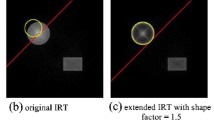Abstract
Shape, in both 2D and 3D, provides a primary cue for object recognition and the Hough transform (P.V.C. Hough, U.S. Patent 3,069,654, 1962) is a heuristic procedure that has received considerable attention as a shape-analysis technique. The literature that covers application of the Hough transform is vast; however, there have been few analyses of its behavior. We believe that one of the reasons for this is the lack of a formal mathematical definition. This paper presents a formal definition of the Hough transform that encompasses a wide variety of algorithms that have been suggested in the literature. It is shown that the Hough transform can be represented as the integral of a function that represents the data points with respect to a kernel function that is definedimplicitly through the selection of a shape parameterization and a parameter-space quantization. The kernel function has dual interpretations as a template in the feature space and as a point-spread function in the parameter space. A novel and powerful result that defines the relationship between parameterspace quantization and template shapes is provided. A number of interesting implications of the formal definition are discussed. It is shown that the Radon transform is an incomplete formalism for the Hough transform. We also illustrate that the Hough transform has the general form of a generalized maximum-likelihood estimator, although the kernel functions used in estimators tend to be smoother. These observations suggest novel ways of implementing Hough-like algorithms, and the formal definition forms the basis of work for optimizing aspects of Hough transform performance (see J. Princen et. al.,Proc. IEEE 3rd Internat. Conf. Comput. Vis., 1990, pp. 427–435).
Similar content being viewed by others
References
P.V.C. Hough, “A Method and Means for Recognising Complex Patterns,” U.S. Patent 3,069,654, 1962.
R.O. Duda and P.E. Hart, “Use of the Hough Transform to Detect Lines and Curves in Pictures,”Comm. ACM, vol. 15, 1971, pp. 11–15.
C. Kimme, D.H. Ballard, and J. Sklansky, “Finding Circles by an Array of Accumulators,”Comm. ACM, vol. 18, 1975, pp. 120–122.
D.H. Ballard, “Generalising the Hough Transform to Arbitrary Shapes,”Patt. Recog., vol. 13, 1981, pp. 111–122.
Y. Muller and R. Mohr, “Planes and Quadrics Detection Using the Hough Transform,” inProc. 7th International Conference on Pattern Recognition, Montreal, 1984, pp. 1101–1103.
C.L. Fennema and W.B. Thompson, “Velocity Determination in Scenes Containing Several Moving Objects,”Comput. Graph., Image Process., vol. 9, 1979, pp. 301–315.
G. Adiv, “Determining Three-Dimensional Motion and Structure from Optical Flow Generated by Several Moving Objects,”IEEE Trans. Patt. Anal. Mach. Intell. vol. PAMI-7, 1985, pp. 384–401.
W.E.L. Grimson and D.P. Huttenlocher, “On the Sensitivity of the Hough Transform for Object Recognition,”IEEE Trans. Patt. Anal. Mach. Intell., vol. PAMI-12, 1990, pp. 255–274.
J. Illingworth and J. Kittler, “A Survey of the Hough Transform,”Comput. Vis., Graph., Image Process., vol. 44, 1988, pp. 87–116.
D.J. Hunt, L.W. Nolte, and W.H. Rueder, “Performance of the Hough Transform and its Relationship to Statistical Signal Detection Theory,”Comput. Vis., Graph., Image Process., vol. 43, 1988, pp. 221–238.
G.C. Stockman and A.K. Agarwala, “Equivalence of Hough Curve Detection to Template Matching,”Comm. ACM, vol. 20, 1977, pp. 820–822.
F.R. Hampel, E.M. Ronchetti, P.J. Rousseeuw, and W.A. Stahel,Robust Statistics—The Approach Based on Influence Functions, New York: John Wiley, 1986.
C.M. Brown, “Inherent Bias and Noise in the Hough Transform,”IEEE Trans. Patt. Anal. Mach. Intell., vol. PAMI-5, 1983, pp. 653–660.
H. Li, M.A. Lavin, and R.J. LeMaster, “Fast Hough Transform: A Hierarchical Approach,”Comput. Vis., Graph., Image Process., vol. 36, 1986, pp. 139–161.
H. Li and M.A. Lavin, “Fast Hough Transform Based on the Bin-Tree Data Structure,” inProc. IEEE Conference on Computer Vision and Pattern Recognition, Miami Beach, FL, 1986, pp. 640–642.
V.F. Leavers and J.F. Boyce, “The Radon transform and Its Application to Shape Parameterization in Machine Vision,”Intl. J. Image Vis. Comput., vol. 5, 1987, pp. 161–166.
T.M.Van Veen and F.C.A. Groen, “Discretisation Errors in the Hough Transform,”Patt. Recog., vol. 14, 1981, pp. 137–145.
J. Princen, J. Illingworth, and J. Kittler, “Hypothesis Testing: A Framework for Analysing and Optimising Hough Transform Performance,” inProc. IEEE International Conference on Computer Vision, 1990. Osaka, Japan, pp. 127–435.
S.R. Deans, “Hough Transform from Radon Transform,”IEEE Trans. Patt. Anal. Mach. Intell., vol. PAMI-3, 1981, pp. 185–188.
W. Niblack and D. Petkovic, “On Improving the Accuracy of the Hough Transform,” IBM Research Report on Computer Science, RS 6577 (63537), November 1988.
P.R. Thrift and S.M. Dunn, “Approximating Point-Set Images by Line Segments Using a Variation of the Hough Transform,”Comput. Vis., Graph., Image Process., vol. 21, 1983, pp. 383–394.
N. Kiryati and A. Bruckstein, “Antialiasing the Hough Transform,” EE Publication 697, Department of Electrical Engineering, Technion, Israel Institute of Technology, December 1988.
J. Princen, “Hough Based Methods for Curve Detection and Parameter Estimation,” Ph.D. thesis, Department of Electronic and Electrical Engineering, University of Surrey, U.K., 1990.
Author information
Authors and Affiliations
Additional information
This work was supported by the Ministry of Defence, Royal Aerospace Establishment, U.K.
Rights and permissions
About this article
Cite this article
Princen, J., Illingworth, J. & Kittler, J. A formal definition of the Hough transform: Properties and relationships. J Math Imaging Vis 1, 153–168 (1992). https://doi.org/10.1007/BF00122210
Issue Date:
DOI: https://doi.org/10.1007/BF00122210




